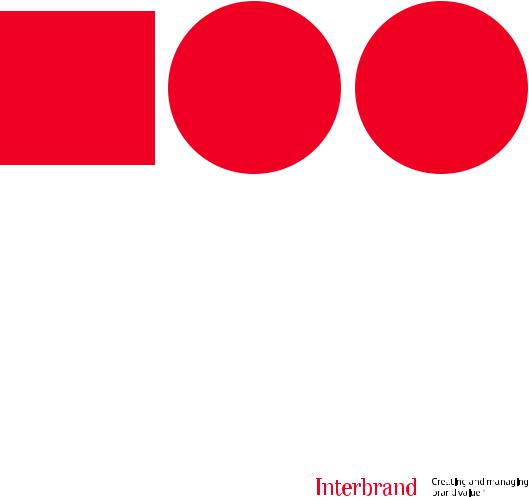
Best Global Brands 2012
.pdf
Best
Global Brands 2012
The definitive guide to the 100 Best Global Brands

Table of Contents
The Future is Human |
The Future of Brand |
|
2 |
Building |
|
Playing to Win on the |
22 |
|
Best Global Brands 2012 |
||
Digital Frontier |
||
6 |
24 |
|
Brand Humanity of |
Sector Overviews |
|
Olympic Proportions |
72 |
|
10 |
Criteria, Methodology, |
|
The World’s |
||
and Brand Strength |
||
Toughest Brands |
134 |
|
14 |
Contributors |
|
Citizens All: The New |
||
142 |
||
Rules of Corporate |
|
|
Citizenship |
|
|
18 |
|

The Future is Human
By Jez Frampton
If 2011 was about upheaval and uncertainty, 2012 has been about transition. Last year, dissent was in the air as protestors took to the streets from Tahrir Square to New York City, a nuclear crisis in Fukushima reignited a worldwide energy debate, and ongoing issues in the banking industry have brought — and continue to bring — deficiencies to the fore. Like it or not, we are entering a
new world. Connected, networked, hyper-aware, and fraught with contradictions, this new world is complex and confusing, but rich, intimate, and alive. It is, for brands, full of promise and boundless possibility — if organizations can learn how to tap into this vast intelligence. The inexorable rise of digital consumers, further accelerated by the mobile and tablet revolution, is radically shifting the dynamics of the marketplace. Facebook, which has forever altered the way we communicate and relate, went public this year. The London Olympics was not only the greenest Olympic event ever staged, but the most digital to date. Welcome to the future.
Information has leveled the playing field, but has also complicated it. Though data — and lots of it — is available to all, that doesn’t mean everyone understands which bits of information are important or how they can be strategically applied. Today’s customers are skeptical, vocal, savvy — and have everyone competing for their attention. Any brand that becomes fixated only on the data, and forgets that those numbers are really people, will be punished swiftly. Big data facilitates personalization, not a return to broadcast. Only brands that stay transparent, actively engaged, and true to their promises will manage to capture hearts and minds, earn trust and loyalty, and command a premium.
Today’s best brands are in touch with their own humanity and the humanity of others. They listen to consumers, employees, and investors alike and respond to the messages they receive.
They want to know how people really feel about their company, they gather input and use it to drive innovation, and they realize that there is a lot to be learned from the wisdom of crowds. The challenge for brands is to respond quickly and with sincerity, or they risk compromising the relationship.
After all, brands evoke emotion. They are personal. They fulfill and delight us. They are reliable, familiar, exciting, surprising, and ever in the fabric of our lives. They are woven into our memories,
Best Global Brands 2012 / The Future is Human

fantasies, and dreams. They have the power to touch and change us precisely because they are human creations, invented in response to both our deepest and most practical needs.
The principles that build and maintain strong brands still hold true, but sometimes we forget that people are really at the center of it all. Resonant symbols, cultural images, emotional attractors, behavior definers — brands are all this and more. They are living business assets: a concept, a feeling, a di erentiating promise that grows, evolves, and will never die as long as a brand is kept alive in the minds of people. In order to succeed, brand owners must become more sensitive to the needs and desires of informed and discerning customers who demand high degrees of engagement — and consistency. And increasingly, the capacity of brands to deepen existing relationships and develop new ones relies on their ability to leverage new technology in service of the human connection.
Those who manage the Best Global Brands 2012 understand the role they play in peoples’ lives, and respond accordingly — building on successes and making up for mistakes. They are constantly nurturing their brands to keep pace in a rapidly changing world; they know that every market is di erent, every interaction counts, and every individual matters. Quite an achievement in such turbulent times. These strong, highly innovative brands have earned the loyalty of many individuals who, collectively, contribute to their power and prosperity. They have also earned our respect and admiration, along with a place in our report.
Jez Frampton
Global Chief Executive
Interbrand

Playing to Win on the Digital Frontier
By Simon Smith and Erica Velis
Digital is advertising’s new ecosystem, a dicey frontier for most major businesses, a new medium for conversation, and a technological wonder that has connected the world. It’s also among the most misunderstood phenomena in business today. We are only just beginning to discover its potential to enhance business and, so far, investing in digital companies has proven to be a gamble. With a billion users on Facebook and 500 million on Twitter, there is no doubt that social media is flourishing. A huge captive audience, and the promise of transforming “likes” into sales, has piqued the interest of investors and companies who want to build their brands and turn key groups of people into paying customers. However, several companies that appeared to be paving the way to the profitable new digital age have faltered, shaking the confidence of investors and resurrecting the ghost of the dot-com bust of 2000.
Heralded with hype, Facebook, Zynga, and Groupon were all heavily promoted and seemed poised to deliver. Facebook’s IPO on May 18, 2012 was a milestone in Silicon Valley and internet business history. On the morning of the 18th, the media clamor reached fever pitch: The Street predicted the stock could rise to $60, $70, even $80 USD; trading broke stock volume records, and the market saw the stock peak at $45 USD. That left the company with a higher market capitalization ($104 billion USD) than all but a few of the largest US corporations. For the moment a winner, CEO Mark Zuckerberg’s personal stock was valued at
$19 billion USD. A few days later, Mark even married his girlfriend of nine years — and let the world know by updating his relationship status. It was a perfect Hollywood ending.
Unfortunately, cracks appeared and the stock kept sliding. The share price dropped over 30% in the first 20 days. Regulators are now investigating the IPO, and more than 40 lawsuits have been filed. A $100 billion USD company just prior to its debut, Facebook is now a $65
USD billion company, beset with problems, and the stock continues to fall. With the IPO a distant memory and the stock value roughly halved, the Facebook brand has taken a hit and the e ects on the market, the sector, and the company itself, are likely to last a while.
Another digital company that has fallen far short of expectations is Zynga. Using Facebook as a platform, Zynga is best known for interactive games like FarmVille and CityVille, and has grown rapidly since it
emerged on the social network scene. Games and apps have exploded in popularity in
the past few years, an outgrowth of social media and the transition to mobile devices. Cheap to produce but often lucrative, Zynga has successfully capitalized on this trend. However, since the company’s December IPO, its shares have dropped 70%; investors worry about the long-term viability of its business model, its dependence on Facebook, and its ability to keep making money from the people who play its digital games.
And then there’s Groupon. Relying heavily on marketing to acquire new customers, Groupon turns a profit by o ering consumers deals
on local goods and services, and splitting the discount proceeds with the participating merchant. Though questions later arose about Groupon’s business model, namely the relationship between marketing spend and its growth rate, Groupon CEO Andrew Mason initially assured investors of his business’ enormous profit potential. However, with an inability to compete with larger discounters like Amazon, the company has shifted from
hypergrowth to stagnation, which has left its stock at a fraction of its recent worth.
Is this the beginning of the end for social media, FarmVille-esque games, and internet daily deals? Haven’t we all heard and seen it before with once-hot internet companies like Netscape, Napster, LimeWire, MySpace, or Friendster? They all dominated the market at one time, then quickly got trumped. It could be that this is just the nature of the digital
Best Global Brands 2012 / Playing to Win on the Digital Frontier

era. The price of entry is low, the growth is quick, and the fall to near-oblivion is swift and hard. Or, could it be, at least in the case of Facebook, that we have a true digital megacompany that will survive the growing pains, find its balance, mature as a brand, and become a leader of the digital frontier?
What all three of these companies have in common is no guarantee of long-term growth and a business model that relies on
“unproven” sources of revenue. Furthermore, they all went public at too high a value, propped up by late-stage money — part of a recent Silicon Valley trend in which prominent investors jump into young companies just before their IPOs. Unprepared for the scrutiny and expectations of Wall Street, issues with the“fundamentals” of all of these companies came to light as soon as the first earnings reports were released. Challenged by the transition to mobile, as well as the fact that their main sources of revenue are dependent on something that doesn’t feel durable and concrete (“likes” on Facebook), it will be hard for such companies to secure the confidence of investors.
Clash of the titans:
Silicon Valley vs. Wall Street
Clearly, Wall Street wants to see results — as in swift growth in revenue. Silicon Valley venture capitalists, however, are focused on the long term. They take the ups and downs of the stock market with a grain of salt and determine the value of an investment based on what it might be worth in a few years, not next quarter. They expect volatility after a company goes public and believe, especially in the case of Facebook, that the downward slide in public valuations, while it may have an e ect on private valuations, will ultimately be manageable.
However, with Facebook and Groupon hitting new lows, concerns about these companies in terms of durability and their ability to grow their business are intensifying — not least of all because of the lock-up expiration on many of the shares that were not on the open market during the IPO. Concerns are even greater for Groupon, not only due to
skepticism over its business model, but also owing to the fact that there are more stocks out there, which is hurting the stock price and spooking investors.
When it comes to Facebook, many are wondering if its CEO has the chops and maturity to grow the social media giant beyond display ads and master the mobile segment. Lured by the size of Facebook’s user base, which has allowed Facebook Inc. to build
a $3 billion-a-year USD advertising business, ad spending has increased. However, because of that, companies are becoming more interested in measuring the results of social media advertisements, which can be hard to quantify. There are also concerns that Facebook’s advertising methods are untested or unproven. For brands, social media is a key part of marketing, a way to build brand awareness. But for investors, the question is: How does all of this translate directly into revenue?
Under similar pressure are Groupon and Zynga. Both companies are losing customers. Zynga, for instance, expected to make just half of what it hoped this year; the company develops games that have little depth, and while people may become obsessed in the short-term, the novelty soon wears o and they move on. Also, more gamers want to play on the go, and Zynga’s mobile games aren’t big hits as of yet. To make matters worse, the brand spends disproportionately on R&D and SG&A (selling, general, and admin), all of which use up much of what profit the company does make, leaving little for shareholders.
One of the di culties with investing in tech companies is the sheer pace of their development. Because they grow so quickly, the start-ups’ initial burst generates excitement, which makes investors want to cash in. But these businesses can also reach saturation in their markets extremely fast. It’s hard
to figure out when the growth might begin to slow down, as it inevitably will. Silicon Valley, with its risk-taking, start-up culture, is more accustomed to the volatility — even expects it — and is, therefore, willing to ride things out. Wall Street, on the other hand,
operates under a di erent paradigm and reacts to the daily ups and downs, which only makes it harder for young companies to regain their luster once Wall Street’s attitude toward them sours.
Wall Street’s minute-by-minute changing of position is out of step with Silicon Valley’s approach to moneymaking. Wall Street wants instant results and Silicon Valley takes a longer-term view. Technological innovation takes time to develop and some attempts
fail — that’s part of the process. In Silicon Valley, where some of the brightest have had multiple start-ups and risen from failure — it’s the price of success. On Wall Street, failure is not an option.
In a recent Wall Street Journal article, Dan Rose, Facebook’s Vice President of Partnerships, is said to have put the company’s situation in perspective at a company meeting in early August. In an attempt to assuage employees who were worried about the stock price, he shared a story from his time at Amazon. The company stock had tanked and, as a father with two young children, Rose became especially concerned about his ability to provide for his family. Facing a tough decision with no obvious answer, he asked himself,“Do we have the right people in place and is our
mission worthwhile?” He believed the answer was yes; rode the situation out, and is, presumably, better o for it. He asked himself the same question about Facebook and is convinced the answer is yes. In the end, it
is our collective confidence in a company that keeps it going — which is why brand management, essentially the management of perception, is so incredibly important.
If the fundamental need to be connected to friends, get daily deals, and play silly games online is still in place, there is hope for Facebook, Groupon, and Zynga, no matter what things look like now. The pressure to please investors will always be there, but whether or not a company survives really depends on how well it pleases the people who use their products or services. When we at Interbrand say brands have the power to change the world, we mean that they have the power to change people’s lives — making life easier, more meaningful, more enjoyable, more convenient and productive. When a brand delivers that, consistently — people love them for it — and everyone, including investors, gets exactly what they hoped for.
If anything, we need a reality check. Not everyone is running away from Facebook’s stock. Investors are not overlooking traditional metrics. Silicon Valley is still rich with investment opportunities. And some people are making a lot of money right now, even as Facebook, Groupon, and some other recent internet IPOs continue to struggle. The internet, today, is no longer a novelty. In fact, the number of people connected to the Web is mind-boggling. So, despite the foreboding comparisons, 2012 is vastly di erent from the dot-com era. There is no reason to lose faith. We’re simply in transition.
Is the bubble about to burst?
It’s true, there are parallels between now and the dot-com days. Back then, the stock prices of internet companies soared to dizzying heights and, as a result, those companies moved faster and with insu cient caution. Market confidence in these companies was high, as was the promise of future profits. Many companies were grossly overvalued. Today, things are di erent — we have the benefit of hindsight.
—Simon Smith is Interbrand’s Digital Director of Europe, the Middle East, Africa & Latin America Erica Velis is the Content Editor for Interbrand’s Global Marketing & Communications team
8 |
Best Global Brands 2012 / Playing to Win on the Digital Frontier |

Brand Humanity of Olympic Proportions
By Lizzy Stallard
Every four years the Olympic Games provide not only the world’s greatest stage for athletes, but a tremendous opportunity for brands to flex their muscles against their rivals too. When it comes to Olympic sponsorship deals, brands invest an enormous amount of time, resources, and billions of dollars. In return in London this year, sponsoring brands gained access to a global audience of 4.8 billion people.
Now that the Games have ended, marketers are focused on the tangible benefits brands experienced. What we should examine are not just immediate, measureable returns, but also what we’ve gained and learned from the Games in 2012 — and the implications for brands going forward.
Firstly, it’s true to say that the idea of celebrat– ing the human spirit has permeated all aspects of the Olympics. This touched London deeply and radiated out to the rest of the world. The performance of sponsoring brands must be seen in this unique context. A staggering 48% of the population of London attended an Olympic event, including many of us in Interbrand’s London o ce—and the atmosphere was indeed inspiring. The feeling of seeing one’s nation win medals in real time is truly incomparable. We were also moved by the immense generosity of spirit from the likes of the 70,000“Games Makers,” the volunteers who so generously gave their time at the games. Amazingly, at the Closing Ceremony, it was these ordinary people who received the greatest cheers of support, perhaps more so than the athletes themselves. The mood trans– formed in London, especially on the Underground, where normally even the slightest eye contact is avoided. Yet, during the Olympics, we let down our guard. Strangers casually struck up conversation around their plans for the day ahead—certainly a rarity until we caught the fever of 2012. Somehow, the superhuman nature of the Olympic Games put us back in touch with our own humanity.
It only seems fitting, given the atmosphere, that brands embraced this same
humanity — and did so with positive impact. In fact, the notion of“brand humanity” was the overriding theme at the Olympics, and it’s a theme worth exploring. Global personal care giant, Proctor & Gamble, for instance, took brand humanity to new heights
with their“Thank You, Mom” campaign. Celebrating the role that mothers play in raising Olympians, the campaign taps into universal sentiment by honing in on the contribution that mothers make in raising successful, well-rounded children. Launched 100 days before the Opening Ceremony, P&G’s biggest campaign in the 175-year history of the company was a huge success, with the supporting brand films garnering almost 15.5 million views around the world. There’s not a product brand in sight, yet its emotional power is unprecedented. The real success of this campaign, of course, is that, without explicitly promoting itself, P&G has accomplished what most marketing e orts fall far short of: inextricably linking the corporate brand with universal human values like family cohesion, mutual love and support, and the dreams of greatness we all have for ourselves and our loved ones. Proving the power of this approach, Interbrand studied consumer associations with this year’s sponsors in the period leading up to the Games and found that P&G enjoyed the greatest increase in brand strength — specifically around values such as credibility and authenticity.
In another example, the o cial oil and gas sponsor, British Petroleum (BP), initially kicked o its communications e ort by focusing on its functional involvement in the Games, such as fueling the Olympic fleet. Interestingly, BP promptly switched to an emotional strategy just four weeks before the Opening Ceremony, when the brand launched its“Here’s to the Home Team” campaign in the UK, spotlighting all those involved in
the behind-the-scenes activity—from the groundsmen and organizers to the athletes and other sponsors. Through this campaign we once again witnessed a brand celebrating the human engine that made the Games
a reality. Despite BP’s troubled past, our
Best Global Brands 2012 / Brand Humanity of Olympic Proportions

research showed that the brand’s e orts aligned well with Olympic values when com– pared with other players, such as Dow and GE.
In a similar vein, McDonald’s celebrated people with their“We All Make the Games” campaign. Personal stories captured via guerilla film crews throughout the Park and the wider city center focused on the emotion at the heart of the Olympics. The multichannel campaign allowed spectators to upload photos of themselves getting into the spirit of the Games—McDonald’s received 20,000 submissions leading up to the Opening Ceremony. McDonald’s is also making heroes of ordinary people across other touchpoints, including in-restaurant. If you’ve walked past a McDonald’s recently, you’ll have noticed their mosaic window displays, capturing portrait photographs of the real people that
make the brand—from suppliers to employees to customers. By capturing, replaying and displaying the moments and emotional responses that make the Olympics so moving and special, McDonald’s celebrated humanity at its best. However, while the brand ultimately succeeded in eliciting a positive response, the appropriateness of McDonald’s role as an Olympic sponsor has been questioned. Our research revealed that 25% of those surveyed felt that the brand was a poor fit with Olympic values. The mixed opinions indicate that many consumers want and expect to see better alignment between the values of sponsoring brands and notions associated with the Olympics, like health and fitness.
EDF Energy also played into the human side, but in a slightly di erent way. The brand capitalized on conversations that undoubtedly occurred worldwide as people fantasized about what it takes to become an Olympic athlete:“What would it be like?”;“What if?”;“How long would it take me?”. In EDF’s playful UK campaign, two eager technicians “test” the equipment ahead of the Opening Ceremony, by taking to the hurdles in the stadium, swimming a length of the Olympic pool, and trying out various other Olympic events. We’d all love to have a go, and this clever, yet simple, piece taps into the desire or intrigue that all of us non-Olympians have felt at one time or another during the Games. This year also saw the greatest investment
from Visa in its 25-year history as an Olympic sponsor. The“Go World” campaign was Visa’s most social ever and put customers firmly
at the center, allowing them to cheer on the athletes through social channels. This is a subtle shift from the Beijing Olympic Games in 2008 where the brand demonstrated its support for the athletes. However, in 2012, Visa celebrated the athletes along with its cardholders. The more inclusive strategy seems to have paid o — to date, 59 million “cheers” have been posted through social channels, and the Go World YouTube channel has received 47 million views. In hindsight, the level of engagement Visa achieved throughout the Olympics is impressive given the significantly high negative sentiment surrounding the brand at the start of the Games. According to our Brand Playback™ tool, which assessed online sentiment,
the exclusivity rights around Visa use were the main contributor to the dissatisfaction many consumers felt.
Those of us from Interbrand’s London o ce did, of course, see some brands continue to push spine-tingling messaging that focused on the might of the athletes in action — such as the adidas“Take the Stage” campaign,
as well as Omega’s“Start Me Up.” However, when we think about the brands that actually cut through in 2012, the most successful were those that resonated with audiences at a far deeper level, celebrating the human spirit, not exceptional human powers.
At this year’s Games, those brands that forged a connection with their customers did so with humanity, acknowledging the participation and accomplishments of everyday people —not just Olympians. Brands that successfully fostered an environment to create customer conversation took home the gold.
A true celebration of the human spirit, it’s no surprise that some are calling the 2012 Olympics“The People’s Games.” The successful brands couldn't have better tapped into that ethos.
—Lizzy Stallard is the Director of New Business & Marketing, Interbrand London

The World’s Toughest Brands: Service brands are some of the hardest to build. Yet greatness is still possible.
By Josh Feldmeth
The Best Global Brands list rewards outcomes. The more economic value you can drive through your brand over time, the higher the valuation. It’s “show me the money,” and the top 100 brands do just that.
But behind the list lies a secret. While all brands are judged by the same criteria, some brands have it harder than others. And services brands may have it hardest of all.
These disadvantaged brands live in a category without tangible products. They have low advertising-to-revenue ratios. They often are run by executives who lack marketing expertise. The responsibility for building culture and insuring consistent delivery is distributed over sprawling organizations of hard-driving, independent-minded talent. In the land of brand building, services businesses must thrive in rocky soil.
So when a strong service brand emerges from these hostile conditions, we take notice, because in their hard-wrought success lies the genetic code of the world’s toughest brands.
One such success story is the business and technology services company, Cognizant. Since its founding in 1994, the company has been on a roll. With more than 140,000
employees and operations in 24 countries, it is one of the fastest-growing technology companies of all time. To help us unpack the story, we interviewed Robert Painter, Cognizant VP of Corporate Marketing. His insight reveals how Cognizant is building a brand with deep roots, an unrelenting vision and a hard-edged accountability — traits shared by the world’s toughest services brands.
Deep roots in authentic soil
There is a conundrum in business services branding: As the business grows, the brand weakens. We call it the Partner Paradox. The more partners (or senior talent in general)
that join the firm, the greater the business growth. But leaders have strong personalities and independent minds. They don’t“do” homogeneity or naturally subvert their own point of view in the interest of a shared vision. That’s the paradox: while brands thrive on clarity and consistency, the thriving business services company actively acquires assets (i.e., people) that, by their very nature, reject common thinking.
Great brands overcome the paradox and subsequently scale the brand globally through a rigorous attention to culture. Accenture’s culture was founded in St. Charles, Illinois, where every new college graduate hire spent the first weeks of their career learning to code while being steeped in Accenture’s cultural DNA. IBM is another example. Its much lauded“Smarter Planet” strategy
has its roots in an internal engagement exercise: its 400,000 plus employees aligned to a single strategy that places them —“I’m an IBMer” — in the center of the frame.
Cognizant’s approach is to ground the culture in the founding energy of its leaders.“I joined Cognizant because of the passion of the leadership,” explains Painter.“When I met with the management for the first time, I realized it was a team that has been here since day one. They’ve experienced remarkable growth. Yet, the only thing they were talking about was the next five years: how to grow, how to expand the brand, how to serve clients better. They all had the same passion.”
The roots of every strong brand are anchored in its culture. This is where Cognizant’s story begins: with a passionate leadership team, galvanized around a shared vision for growth and committed to culture. It’s the same for Accenture, IBM, and the other big services brands. It’s textbook stu really, but for business services firms, particularly those that are growing quickly globally, it’s a very rare and di cult thing.
Best Global Brands 2012 / The World’s Toughest Brands

Unrelentingly relevant
Everyone’s on the bus, but is it headed in the right direction? This is a particularly tricky question in the world of technology. How does the brand ensure that its enduring vision will consistently win in a constantly evolving sec– tor? Cognizant’s answer is simple: be relevant.
Again, Painter:“Branding in technology services is one of the most challenging marketing jobs that you can imagine. It all comes down to a simple term: relevance. We don’t wake up and say,‘How do we make the brand better?’ We say,‘Are we being as relevant to our clients as possible?’”
The most relevant brand will always win. It will be chosen more frequently, given a premium, and recommended to others.
Yet in the world of technology, what is relevant today may not be relevant tomorrow. Cognizant’s response is a brand proposition that doesn’t anchor on something that is relevant — smartest consultants, best price, most flexible, most global, etc. Rather, they aim simply to be the most relevant.
It’s a positioning masterstroke. It’s simple, memorable, and animating for the organization. It’s guaranteed to drive revenue and profit. And it demands the best from the culture: vigilance to client needs, flexibility, open-mindedness and restlessness for future work. This is strategy in action; a living brand positioning that exists in the client experience, not in the brand strategy presentation.
SAP is the classic example of the case. Since 2000, the brand has been anchored to the purpose of “turning businesses into best-run businesses.” For a company selling software, nothing could be more relevant. And they haven’t wavered, continuing to build around a core proposition year after year. In an industry where“what’s hot” changes by the hour, these brands are unrelentingly focused on what will be relevant for clients, forever.
The freedom of accountability
I used to work for a large management consultancy, and I loved it. We were called
in when the problems became too di cult for the client’s management teams. We presented to the C-suite. We had the facts and all the confidence in the world.
It’s not surprising, then, that those responsible for building brands within highperforming services organizations often shy away from accountability. They often don’t have the data they want, and the management to which they report are experts in business strategy and financial engineering. It can be daunting. But where others may see a debilitating need for accountability, the world’s toughest services brands see liberation.
Painter says,“I sometimes feel my job is on the easier side. I’m blessed with management and a board that is clear about the strategic direction, and how we are going to be relevant for our clients. As a marketing executive, this is a real luxury.”
Painter may feel his job has relative advantages, but he certainly hasn’t taken the easy path.
He’s documented a brand journey, a step- by-step road map for building the brand between now and 2015. Each milestone can be measured quantitatively. And while
other brands have similar road maps, what’s unique about the Cognizant brand team is their insistence on being held accountable by the organization.
Painter finds this accountability liberating. “These aren’t metrics we keep within corporate marketing. We go to great lengths to share our goals and performance against them with the management team and the board. Quantitative measures are the key. It makes the conversation with the CFO easier with quarterly return on investment. We have nowhere to hide, which I find
very reassuring.”
—Josh Feldmeth is Chief Executive O cer, Interbrand New York
16
